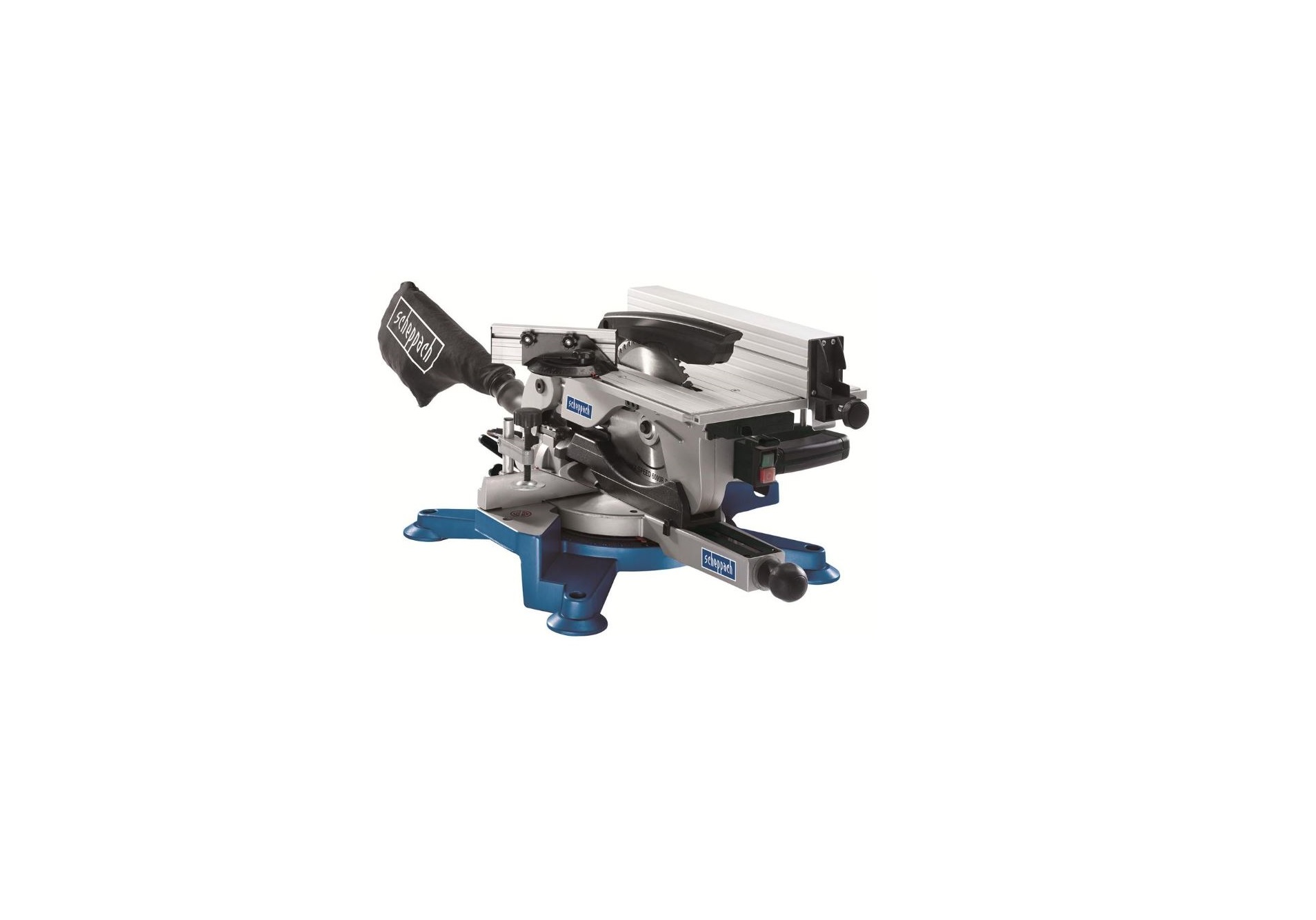scheppach 5901103901 254 mm Table Crosscut and Mitre Saw Instruction
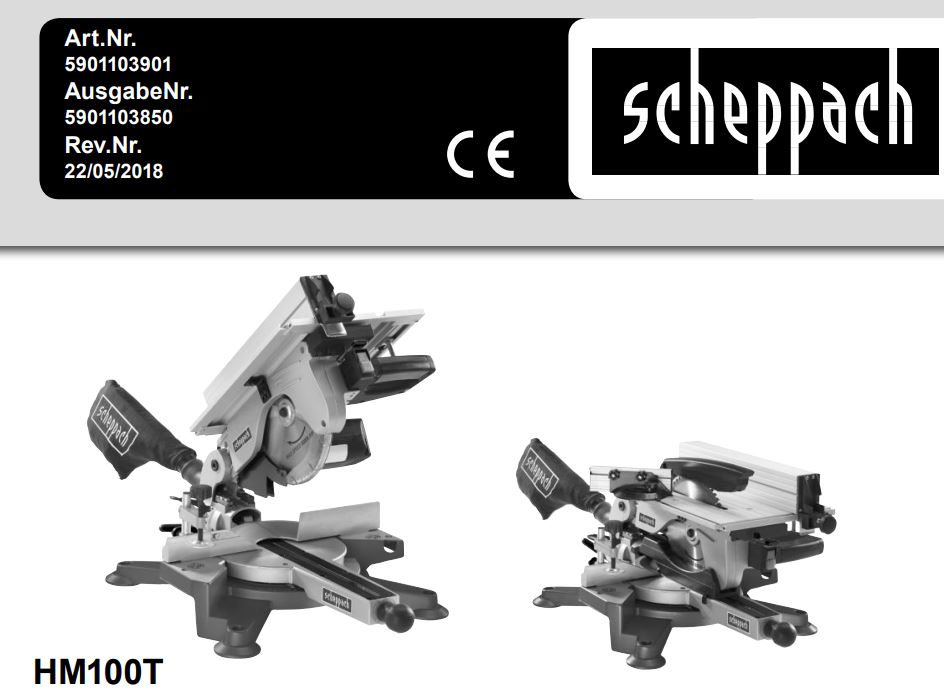
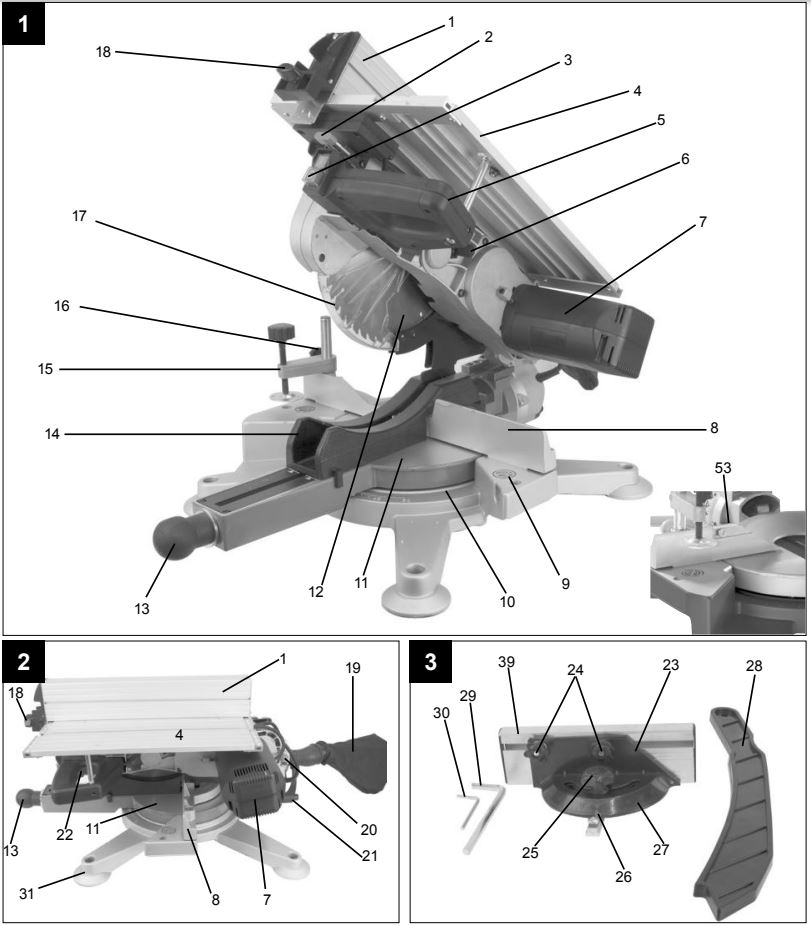
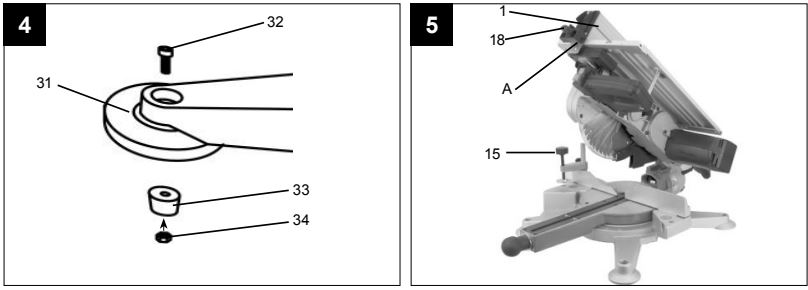
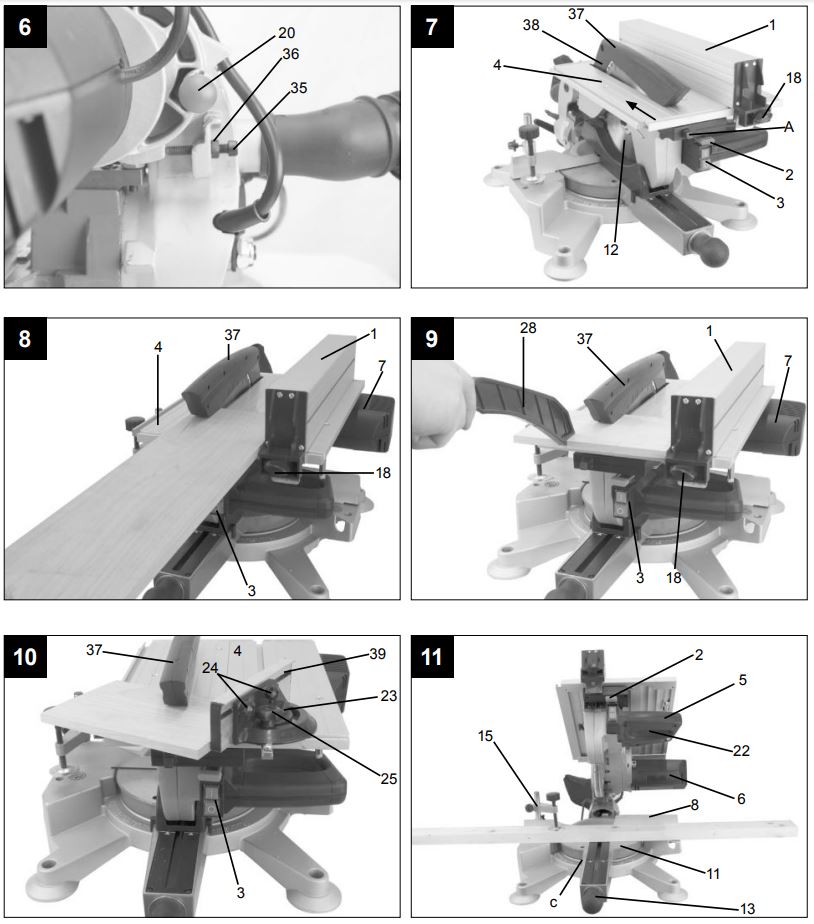
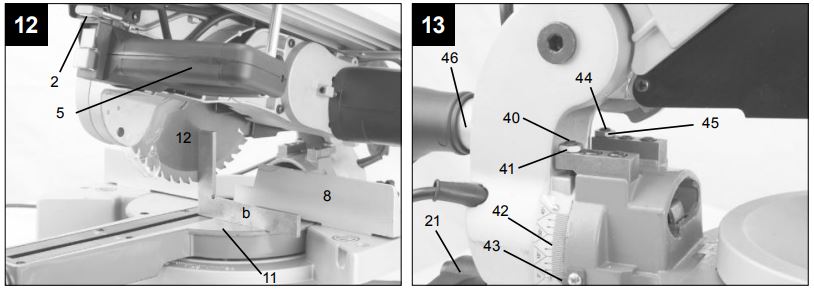
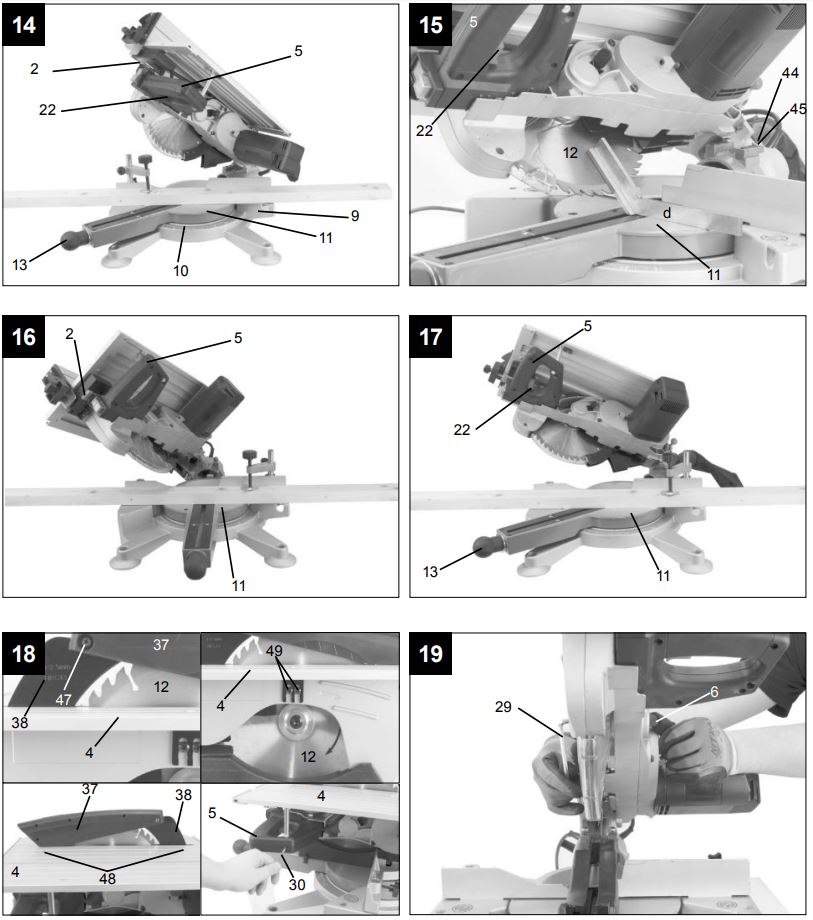
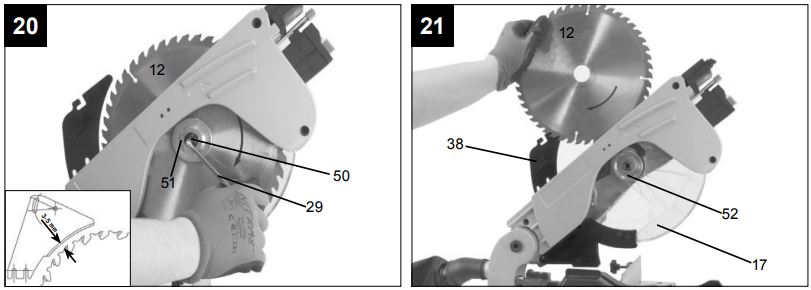
Explanation of symbols on the machine
The use of symbols in this handbook is designed to direct your attention to possible risks. You must make sure that you understand the safety symbols and explanations accompanying them. Warnings themselves cannot remove risks and cannot substitute correct action for the prevention of accidents.
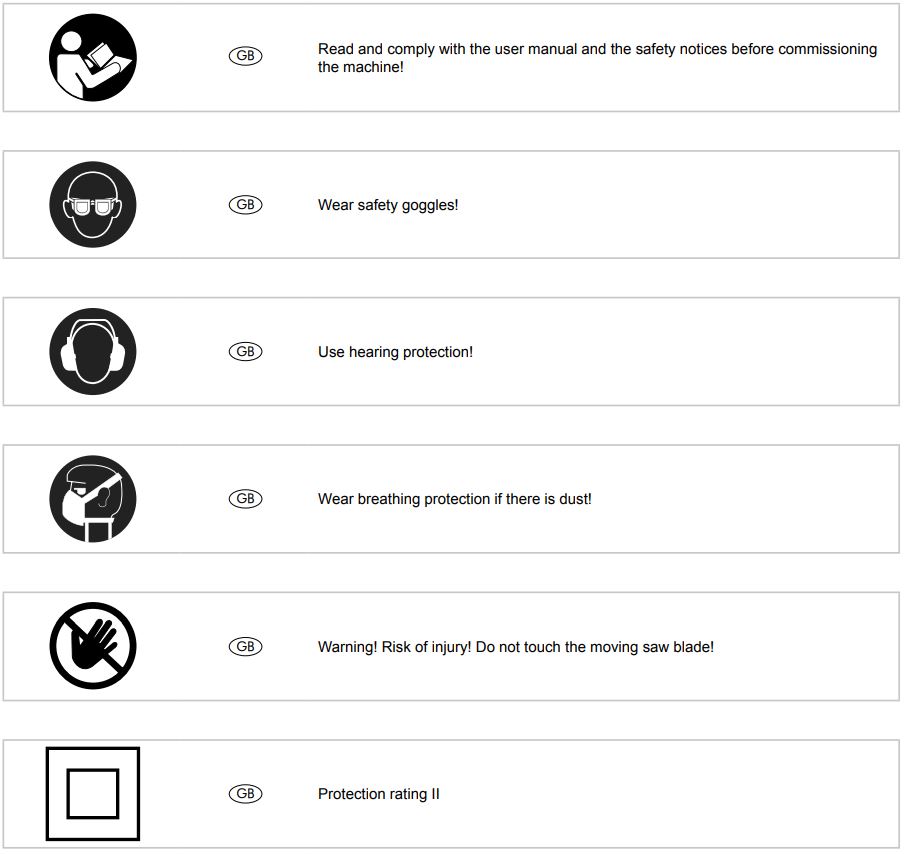
1. Introduction
Manufacturer: scheppach Fabrikation von Holzbearbeitungsmaschinen GmbH Günzburger Strasse 69 D-89335 Ichenhausen
Dear Customer, We hope you enjoy working with your new machine and we wish you every success.
Note: According to the applicable Product Liability Law, the manufacturer of this device is not liable for injury to persons or damage caused to or by this device in the event of:
- improper handling,
- non-compliance with the operating instructions,
- repairs by third parties who are not authorised specialists,
- installation and replacement of non-original spare
parts, - use other than for the intended purpose,
- failure of the electrical equipment in the event of
non-compliance with electrical instructions and VDE Specifications 0100, DIN 57113 / VDE 0113.
Please note: Before assembling and commissioning the device, read the entire user manual. This user manual is designed to make it easier for you to get to know your machine and to use it for its intended purpose. The user manual contains important information about how you can work with the machine in a safe, professional and economic way, how you can prevent hazards, save money on repairs, reduce downtimes and increase the reliability and durability of the machine. In addition to the safety instructions in this user manual, you must also, without fail, observe the regulations relevant to your country for the operation of this machine. Store the user manual in a plastic cover close to the machine, protected from dirt and moisture. It must be read and followed carefully by every user before working with the machine. Only those who have been instructed in the machine`s use and taught about associated hazards, may use it. The minimum age requirement must be complied with. In addition to the safety notices contained in this operating manual and the particular instructions for your country, the generally recognised technical regulations for the operation of identical devices must be complied with.
2. Machine description
- Rip fence
- Unlocking button
- On/off switch for table operation
- Upper saw table
- Handle
- Saw-shaft lock
- Motor
- Extension fence
- Lower saw table
- Dial
- Lower saw table
- Saw blade
- Locking button
- Lower saw blade cover
- Work piece holder
- Mitre lock
- Saw blade guard, moveable
- Lock screw
- Wood chip collection bag
- Lock pin
- Set screw
- On/off switch for chopping operation
- Cross stop
- Star knob screws
- Star knob screw
- Indicator
- Dial
- Push stick
- Allen key 6 mm
- Allen key 3 mm
- Foot
- Allen screw
- Rubber foot
- Nut
- Screw
- Fixing nut
- Upper saw blade guard
- Riving knife
- Extension fence
- Allen screw
- Lock nut
- Angle indicator
- Indicator
- Allen screw
- Lock nut
- Dust extraction nozzle
- Screws (saw blade guard)
- Screws (upper saw table)
- Screws (lower saw table)
- Flange screw
- Outside flange
- Inside flange
- Moveable stop rail
3. Delivery contents
1 x table/chop/mitre saw
1 x carbide tipped saw blade
1 x Allen key 6 mm
1 x Allen key 3 mm
1 x rip fence
1 x cross stop
1 x push stick
- Open the packaging and carefully remove the machine.
- Remove packaging and transportation safety devices (if applicable).
- Check that the delivery contents are complete.
- Check machine and accessories for damage caused during transport. In the event of complaints, you must contact the distributor without delay. Claims at a later stage will not be accepted.
- If possible, store packaging until the warranty expires.
- Before handling the device, make yourself familiar with it by reading these operating instructions.
- For accessories, consumables and spare parts, only ever use original parts. Spare parts are available from your stockist.
- Include our item number, the device type and year of manufacture in your order.
⚠ WARNING!
The device and the packaging materials are not toys! Children must not play with plastic bags, plastic sheeting and small parts!
⚠ DANGER
Risk of choking and suffocation!
4. Intended use
The machine is suitable for applications using an AC source of 230 V. You must make sure you observe the restrictions specified in the safety notices.
The table, chop and mitre saw with upper table is designed for chopping as well as lengthwise and crosswise cutting (only with cross stop) of wood and plastic, in accordance with the size of the machine. The saw is not suitable for cutting fire wood.
Only ever use saw blades suited to the machine. The use of cutting discs of any kind is prohibited.
Only ever use the machine for its intended purpose. Every use beyond that is deemed as not intended. The user/operator, and not the manufacturer, is liable for damage or injury of any kind caused by use other than that intended.
Please note that our machines have not been constructed for commercial, technical or industrial use. We do not assume any guarantee if the machine is used in commercial, technical or industrial settings or for tasks of this kind.
5. Safety notices
In this user manual, we have marked sections concerning your safety with this sign:
Additionally, the operating manual contains other important text passages which are marked with the word ,,WARNING!”.
⚠ WARNING!
When using machines, safety measures must be complied with in order to prevent injury and damage. Therefore, carefully read this operating manual/these safety notices. If you hand over the machine to others, please also pass on this manual/these safety notices. We are not liable for accidents or damage caused by non-compliance with this manual and these safety notices.
⚠ DANGER
If this instruction is not complied with, there is a considerable danger to life or the risk of life-threatening injuries.
⚠ WARNING
If this instruction is not complied with, there is a danger to life or the risk of severe injuries.
⚠ CAUTION
If this instruction is not complied with, there is a slight to medium risk of injury.
⚠ NOTICE
If this instruction is not complied with, there is a danger of damaging the motor or other objects.
General safety notices
- Keep your work area tidy.
· If your work area is not tidy, this can lead to accidents. - Take ambient conditions into account.
· Do not subject power tools to rain.
· Do not use power tools in a damp or wet environment.
· Make sure your work area is well lit.
· Do not use power tools where there is a risk of fire or explosions. - Protect yourself from electric shock.
· Avoid body contact with earthed parts (e.g. pipes, radiators, electric cookers, cooling units). - Keep others away.
· Do not let others, particularly children, touch the power tool or the cable. Keep them away from your work area. - Safely store power tools which are not being used.
· Power tools which are not being used must be stored in a dry, high up or locked place, beyond the reach of children. - Do not overload your power tool.
· It is better and safer to work within the specified power range. - Use the correct power tool.
· Do not use under-powered machines for hard work. · Do not use the power tool for purposes for which it is not intended. For example, do not use hand-held circular saws for cutting branches or logs. - Wear suitable clothing.
· Do not wear baggy clothing or jewellery. It may get caught in moveable or rotating parts.
· When working outside, non-slip shoes are recommended.
· Wear long hair in a hair net. - Use protective equipment.
· Wear safety goggles.
· If your work creates dust, wear a face mask. - Attach the dust extraction equipment.
· If equipment for dust extraction and collection is available, make sure it is attached and used properly. - Do not use the cable for purposes for which it is not intended.
· Do not use the cable to pull the plug from the socket. Protect the cable from heat, oil and sharp edges. - Secure the work piece.
· Use clamping devices or a vice to secure the work piece. This is safer than using your hand.
· For long work pieces, an additional support (table, bracket etc.) is required in order to prevent the machine from tipping.
· Always push the work piece tightly against the work top and fence in order to prevent wobbling or twisting of the work piece. - Avoid an abnormal posture.
· Ensure secure footing and always keep your balance. - Carefully look after your tools.
· Keep cutting tools clean and sharp so you can work better and more safely.
· Follow instructions for lubrication and tool replacement.
· Regularly check the connection cable of the power tool and have it replaced by a specialist in the event of damage.
· Check extension leads regularly and replace them when they are damaged.
· Keep handles dry, clean and free from oil and grease. - Remove the plug from the socket · when the power tool is not being used, before maintenance and when replacing parts such as the saw blade, drill bit, cutter.
- Do not leave tool keys in the machine.
· Before turning on the machine, make sure that tool keys and adjustment tools have been removed. - Prevent unintentional start-up.
· Ensure that the switch is turned off when putting the plug into the socket. - Use extension leads when working outside.
· When working outside, only ever use extension leads approved and marked accordingly. - Be careful.
· Watch what you are doing. Be sensible at work. Do not use the power tool when you are not concentrating. - Check the power tool for potential damage.
· Before using the power tool, carefully check safety equipment or slightly damaged parts to ensure their flawless and intended function.
· Check whether the moveable parts are working without problem and do not jam, and whether parts are damaged. All parts must be installed properly and meet all conditions in order to guarantee flawless operation of the power tool.
· Damaged safety equipment and parts must be repaired by an authorised specialist or replaced if nothing else is specified in the manual.
· Damaged switches must be replaced by the service workshop.
· Do not use power tools where the switch cannot be switched on and off. - WARNING! · Use of other tools and other accessories can pose a risk of injury.
- Have your power tools repaired by an electrician.
· This power tool complies with relevant safety stipulations. Repairs must be carried out by an electrician using original spare parts; otherwise accidents may be caused to the user.
Warning! This electric tool generates an electromagnetic field during operation. This field can impair active or passive medical implants under certain conditions. In order to prevent the risk of serious or deadly injuries, we recommend that persons with medical implants consult with their physician and the manufacturer of the medical implant prior to operating the electric tool.
Particular safety notices
Safety measures
- Deformed or cracked saw blades must not be used.
- Replace worn table inserts.
- Only ever use saw blades recommended by the manufacturer which comply with EN 847-1.
- ⚠ WARNING! When replacing the saw blade, make sure that the cutting width is not smaller and the main blade width is not bigger than the width of the riving knife.
- Make sure you select the appropriate saw blade for the material you are cutting.
- If required, wear personal protective equipment. This may include:
- Hearing protection to reduce the risk of becoming hearing impaired;
- Breathing protection to reduce the risk of inhaling hazardous dust;
- When handling saw blades and rough work pieces, wear gloves. Whenever feasible, carry saw blades in a container.
- The following factors can influence dust release:
- Worn, damaged or cracked saw blades;
- Recommended extraction capacity of the extraction unit 20 m/s;
- The work piece must be guided correctly;
- Saw blades made of high-alloy high speed steel (HSS steel) must not be used.
- The push stick or the handle for a push block should be stored by the machine when it is not being used.
- Use the saw only when its safety equipment is in position, particularly after changing the sawing mode, and when the guard is in a good condition and has been properly maintained.
Maintenance and service
- The following conditions can influence the impact of noise on the operator:
- Type of saw blade (e.g. saw blades to reduce noise);
- Work piece material;
- Force with which the work piece is pushed against the saw blade;
- Machine faults, including safety equipment and saw blade, must be reported to the person in charge of safety as soon as they are detected.
Safety notices for operation as chop and mitre saw
Safe operation
- Select a saw blade suitable for the work piece you are cutting.
- Never use the table, chop and mitre saw for cutting material other than that specified by the manufacturer.
- When transporting the machine, use the transport device. Never use safety equipment for handling or transporting the machine.
- Use the saw only when it is in a good condition and has been maintained properly.
- Make sure that the device for swivelling the arm is securely fastened when using the mitre saw.
- The floor surrounding the machine must be level, clean and free from loose material such as wood chippings and offcuts.
- Ensure there is sufficient lighting in your work area and in the room.
- The operator must be trained sufficiently in the setup, use and operation of the machine.
- Only ever use saw blades which have been sharpened properly. The maximum rotational speed specified on the saw blade must be complied with.
- Make sure you only use spacers and spindle rings which are suitable for the intended purpose specified by the manufacturer.
- If the machine is equipped with a laser, this laser must not be replaced by a laser of another type. Repairs must be carried out by the laser manufacturer or an authorised representative.
- Do not remove offcuts or other work piece parts from the cutting area while the machine is running and the blade has not yet come to a standstill.
- Make sure that the machine, if possible, is secured to a work bench, a table or the base frame.
- Prevent long work pieces from tipping at the end of the cutting process (e.g. roller stand).
Additional information
- Remove the plug from the mains before any adjustment or maintenance work.
- Pass on the safety notices to everyone working with the machine.
- Do not use the saw for cutting fire wood.
⚠ CAUTION
- The rotating saw blade poses the risk of injury to hands and fingers.
- Before commissioning the machine, check whether the voltage on its rating plate corresponds with the mains voltage.
- If an extension lead is required, ensure that its cross section is sufficient for the current consumption of the saw. Minimum cross section 1.5 mm2 .
- Fully extend the cable from the cable drum before use.
- Do not carry the saw by the mains cable.
- Do not subject the saw to rain and do not use the machine in a wet or damp environment.
- Ensure good lighting.
- Do not saw close to flammable liquids and gases.
- Wear suitable work clothing! Baggy clothing and jewellery can be caught in the rotating saw blade.
- The operator must be at least 18 years old.
- Keep children away from the machine when it is connected to the mains.
- Check the mains connection cable. Do not use faulty or damaged connection cables.
- Keep your work area free from wood waste and parts lying around.
- People working with the machine must not be distracted.
- Adhere to the rotational direction of motor and saw blade.
- Do not, under any circumstances, stop the saw
blade after turning the power off by pushing it sideways. - Fit well-sharpened, flawless and true saw blades only.
- Only tools that comply with EN 847-1 should be used with the machine.
- Faulty saw blades must be replaced immediately.
- Only use saw blades that comply with the specified data in the user manual.
- Make sure that the arrow on the saw blades corresponds with the arrow on the machine.
- After the plug has been removed from the mains, ensure that the saw blade does not touch the rotary table in any position, by turning the saw blade in the 45° and 90° position with your gloved hand. If applicable, adjust the saw head.
- Ensure that all devices covering the saw blade work flawlessly.
- The moveable protection cover must not be locked open.
- The machine`s safety devices must not be removed or made unusable.
- Damaged or faulty safety equipment must be replaced immediately.
- Do not cut work pieces that are too small to hold safely in your hand.
- Avoid awkward hand positions in which one or both hands could touch the saw blade in the event of sudden slipping.
- For long work pieces, an additional support (table, bracket etc.) is required in order to prevent the machine from tipping. ·
- There must not be any nails or other foreign objects in the part of the work piece that is being cut.
- Always position yourself to the side of the saw blade when working.
- Do not load the machine so much that it comes to a standstill.
- Always push the work piece tightly against the work top and fence in order to prevent wobbling or twisting of the work piece.
- Make sure that there is enough space to the side of the saw blade so cut-offs can fall away freely. Otherwise, they may be caught by the saw blade and be ejected.
- Never saw several work pieces at the same time.
- Never remove loose splinters, wood chippings or jammed wood when the saw blade is rotating.
- Turn off the machine before clearing faults or removing jammed wood. -Disconnect the mains plug· With the motor turned off, carry out modifications, as well as adjustment, measurement and cleaning work. – Disconnect the mains plug
- Before turning on the machine, make sure that tool keys and adjustment tools have been removed.
- Turn off the motor and remove the mains plug before you leave your work area.
- Electrical installations, repairs and maintenance must be carried out by specialists.
- All protective and safety equipment must be reattached immediately after completing repairs and maintenance.
- The manufacturer’s stipulations concerning safety, work and maintenance as well as the measurements specified in Technical Data, must be complied with.
- The relevant accident prevention stipulations and other widely recognised safety rules must be observed.
- Attach the dust extraction unit for every job.
- Operation in a closed room is permitted only with a suitable extraction unit.
- Do not use under-powered machines for hard work.
- Do not use the cable for purposes for which it is not intended!
- Ensure secure footing and always keep your balance. · Check the machine for potential damage!
- Before using the machine, carefully check safety equipment or slightly damaged parts to ensure their flawless and intended function.
- Check whether the moveable parts are working without problem and do not jam, and whether parts are damaged. All parts must be installed properly and meet all conditions in order to guarantee flawless operation of the machine.
- Damaged safety equipment and parts must be repaired by an authorised specialist or replaced if nothing else is specified in the manual.
- Have damaged switches replaced by a service workshop.
- This machine complies with relevant safety stipulations. Repairs must be carried out by an electrician using original spare parts; otherwise accidents may be caused to the user.
- Replace worn table inserts.
- Do not use saw blades made of high speed steel.
- Make sure that the device for swivelling the arm is securely fastened when using the mitre saw.
- Be careful when working at a right angle.
- WARNING! You must be particularly careful when carrying out double mitre cuts!
- Do not overload your machine.
- Wear safety goggles.
- If your work creates dust, wear a face mask.
- Check the cable/extension lead for damage.
- Wear gloves when handling saw blades.
Safety notices for operation as a table circular saw
Safe operation
- Use the push stick or the handle with push block to guide the work piece safely past the saw blade.
- Use the riving knife and set it up correctly.
- Use the upper saw blade guard and set it up correctly.
- Circular saws must not be used for slotting (cutting a groove in the work piece).
- Always use saw blades where the maximum permitted speed is not less than the maximum spindle speed of the table circular saw and the material you are cutting.
- When transporting the machine, use the transport device. Never use safety equipment for handling or transporting the machine.
- During transport, the upper part of the saw blade must be covered, for example by the guard.
- Prevent long work pieces from tipping at the end of the cutting process (e.g. roller stand).
Additional information
Pass on the safety notices to everyone working with the machine.
- Do not use the saw for cutting fire wood.
- Do not crosscut round timber.
⚠ CAUTION
- The rotating saw blade poses the risk of injury to hands and fingers.
- The machine is equipped with a safety switch to protect against turning on after a voltage drop.
- Before commissioning the machine, check whether the voltage on its rating plate corresponds with the mains voltage.
- If an extension lead is required, ensure that its cross section is sufficient for the current consumption of the saw. Minimum cross section 1.5 mm2.
- Fully extend the cable from the cable drum before use.
- Check the mains connection cable. Do not use faulty or damaged connection cables.
- The operator must be at least 18 years old.
- Keep your work area free from wood waste and parts lying around.
- People working with the machine must not be distracted.
- Adhere to the rotational direction or motor and saw blade.
- Do not, under any circumstances, stop the saw blade after turning the power off by pushing it sideways.
- Fit well-sharpened, flawless and true saw blades only.
- The machine`s safety devices must not be removed or made unusable.
- Faulty saw blades must be replaced immediately.
- Do not use saw blades that do not comply with the specified data in the user manual.
- Ensure that all devices covering the saw blade work flawlessly.
- WARNING! Insert cuts must not be carried out with this saw.
- Damaged or faulty safety equipment must be replaced immediately.
- The riving knife is an important safety device which guides the work piece and prevents closure of the cut kerf behind the saw blade and recoil of the work piece. Observe the width of the riving knife. The riving knife must not be thinner than the saw blade body and not wider than its cut kerf width.
- During every operation, the protective cover must be lowered onto the work piece.
- When cutting small work pieces lengthways, make sure you use a push stick (width smaller than 120 mm).
- Do not cut work pieces that are too small to hold safely in your hand.
- When cutting small pieces of timber, the rip fence must be secured on the correct side of the saw blade.
- Always position yourself to the side of the saw blade when working.
- Do not load the machine so much that it comes to a standstill.
- Always push the work piece tightly down onto the work top.
- Ensure that cut off timber pieces are not caught by the saw blade`s teeth and ejected.
- All protective and safety equipment must be reattached immediately after completing repairs and maintenance.
- The manufacturer’s stipulations concerning safety, work and maintenance as well as the measurements specified in Technical Data, must be complied with.
- The relevant accident prevention stipulations and other widely recognised safety rules must be observed.
- Adhere to specifications by the staff association.
- Attach the dust extraction unit for every job. The operator must be informed of the conditions which influence dust release, e.g. the type of material (registration and source), the significance of local precipitation and the correct setting of guards/guiding plates/guidance bars.
- Operate the saw only with a suitable extraction unit or a commercially available industrial vacuum cleaner.
- Never remove loose splinters, wood chippings or jammed wood when the saw blade is rotating.
- Turn off the machine before clearing faults or removing jammed wood. -Disconnect the mains plug· Replace the table insert when the sawing gap is worn away. – Disconnect the mains plug
- This machine complies with relevant safety stipulations.
- Keep your work area clean and tidy. Untidiness and unlit work areas can lead to accidents.
- Keep the machine away from rain and wet conditions. Water ingress into the power tool increases the risk of an electric shock.
- Be careful, watch what you are doing and work sensibly with your power tool. Do not use the machine when you are tired or under the influence of drugs, alcohol or medication. A moment of carelessness when using the power tool can lead to serious injury.
- Do not use a power tool which has a faulty switch. A power tool which cannot be turned on or off, is dangerous and must be repaired.
- Power tools which are not being used should be stored beyond the reach of children.
- Do not let others use the machine if they are not familiar with it or have not read these instructions. Power tools are dangerous when they are being used by inexperienced people.
- Keep your cutting tools sharp and clean. Carefully maintained cutting tools with sharp cutting edges jam less and are easier to guide.
- If the power tool`s connection cable is damaged, it has to be replaced by a specially pre-adjusted connection cable which is available from the customer service organisation.
- Have your machine repaired by qualified specialists and only with original spare parts. This ensures the safety of the machine.
- The position of the machine must be stable.
- Before commissioning, all covers and safety devices must be installed correctly.
- The saw blade has to be able to run freely.
- In the event of timber which has already been used, watch for foreign objects such as nails or screws etc.
- Before turning on the main switch, make sure that the saw blade is mounted correctly and all moving parts run smoothly.
Additional safety notices for table, chop and mitre saws
- Ensure that, in table circular saw mode, the arm is positioned tightly in the work position.
- Ensure that, in table circular saw mode, the arm is secured properly for inclined cuts.
- Ensure that the table is secured properly when the operating mode of the saw is changed.
1) Safety measures
- Do not use damaged or deformed saw blades;
- Use the saw only when its safety equipment is in position, particularly after changing the sawing mode, and when the guard is in a good condition and has been properly maintained.
- Replace worn table inserts;
- Only ever use saw blades which are recommended by the manufacturer and comply with EN 847-1, alongside a warning sign that the riving knife must not be wider than the cut kerf width and not thinner than the saw blade body;
- Ensure that the rip fence is secured properly when cutting diagonally;
- Do not use saw blades made of high speed steel;
- Connect the saw to an extraction unit when cutting timber.
- Wear appropriate personal protective equipment. This may include:
- Hearing protection to reduce the risk of becoming hearing impaired;
- Breathing protection to reduce the risk of inhaling harmful dust;
- Wear gloves when handling saw blades and rough material (saw blades must be transported in a suitable container whenever feasible);
- Ensure that the material to be cut is taken into account when selecting the saw blade.
- Always return the push stick to its bracket when it is no longer being used.
2) Maintenance and care
- Observe the manufacturer`s notices concerning possible noise reduction (e.g. using saw blades which have been constructed for lower noise pollution, and saw blade and machine maintenance).
- Machine faults, including guards or saw blades, must be resolved as soon as they are detected.
3) Working safely
- Select a saw blade suitable for the material you are cutting;
- Never use the saw for cutting materials other than those recommended by the manufacturer;
- The floor surrounding the machine must be level, clean and free from loose material such as wood chippings and offcuts;
- Make sure the room and your work area are well lit;
- Comply with the instructions for replacing the saw blade.
⚠ WARNING
- In the circular saw and mitre saw mode, the safety devices have to be returned to their proper position.
- In the table circular saw mode, a push stick or a push block with handle has to be used in order to prevent the operator getting too close to the saw blade with his/her hand when working.
- The operator must be trained sufficiently in the setup, use and operation of the machine;
- Ensure that the arm of the saw is secured properly when cutting diagonally;
- Ensure that the arm of the saw is secured properly in the work position when in table circular saw mode;
- Before leaving the work area, turn off the saw;
- Ensure that the circular saw table is secured at the selected height;
- Only ever use saw blades which have been sharpened properly. Do not exceed the maximum rotational speed specified on the saw blade;
- Make sure you only use spacers and spindle rings which are suitable for the intended purpose specified by the manufacturer;
- If the machine is equipped with a laser, this laser must not be replaced by a laser of another type. Repairs must be carried out by the laser manufacturer or an authorised representative;
- Ensure that the upper part of the saw blade is completely enclosed when in mitre saw mode;
- Replacement and alignment of the saw blade have to be carried out properly;
- Make sure that the machine, if possible, is secured to a work bench or a table.
- Do not remove offcuts or other work piece parts from the cutting area while the machine is running and the blade has not yet come to a standstill;
- In the table circular saw mode, use a riving knife and set it up properly; (Fig. 20)
- The machine must not be used for slotting (insert grooves);
- During transport, the upper part of the saw blade must be covered, e.g. by the upper guard, or the saw blade must be in its lowest position;
- In the table circular saw mode, the lower saw safety device must be used and set up properly.
⚠ WARNING
- The vibration levels during operation of the power tool can deviate from the specified vibration levels, depending on the application of the power tool.
⚠ WARNING
- Restrict the work time and reduce the actual operating time to lower the risk of vibration.
Remaining risks
Even when you use the machine for its intended purpose, certain risks remain that cannot be completely avoided. Based on the construction and set-up of the machine, the following issues may occur:
- Contact with the saw blade in an uncovered area of the saw
- Touching the rotating saw blade (cut)
- Recoil of work pieces and ejection of work piece parts
- Saw blade breakage
- Ejection of faulty carbide saw blade parts
- Hearing damage when not using the required hearing protection
- Harmful emission of wood dust when the machine is used in a closed room
- Risk of injury during tool replacement
The following factors affect noise emission:
- material to be cut
- type of saw blade
- feed force
The following factors affect dust development:
- worn saw blades
- dust extraction units with an air speed of less than
20 m/s - work piece not guided properly Working on particular timber such as beech and MDF can cause dangerous dust during sawing.
Therefore, a dust extraction unit must be used.
6. Technical Data
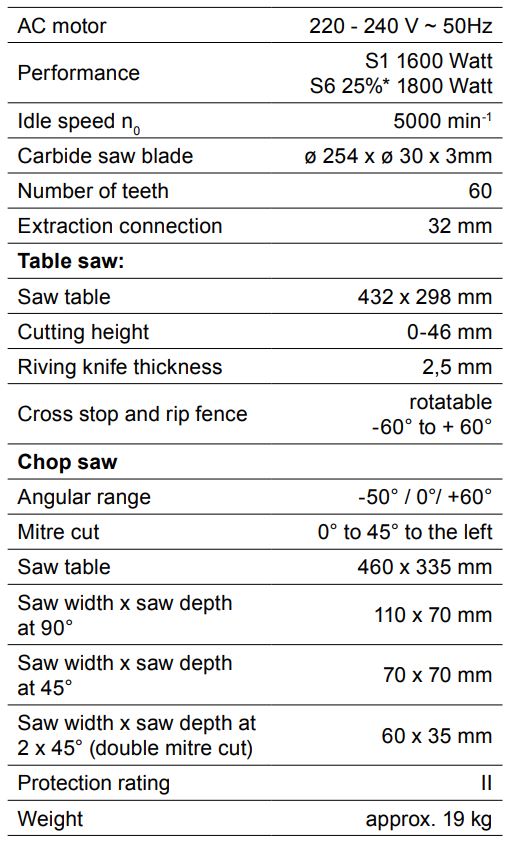
Subject to technical changes!
* Operating mode S6, uninterrupted, continuous operation. Operation consists of a start-up time, a period of constant load and idle time. The cycle duration is 10 mins, the relative start-up time is 25% of the cycle duration.
Information concerning noise emission measured according to relevant standards: Sound pressure LpA = 92.5 dB(A) Sound power LwA = 105.5 dB(A) Measurement uncertainty KpA = 3.0 dB(A) Use hearing protection. Noise at the work place can exceed 85 db (A). In this case, sound protection measures are required for the user. Being subjected to noise can cause hearing loss. The overall vibration values (vector sum of three directions) have been determined according to EN 61029
The noise from this saw has been measured according to DIN ENISO 3744; 11/95, E DIN EN 31201; 6/93, ISO7960 Appendix A; 2/95. Vibration emission value ah = 1.74 m/s2 Uncertainty Kh = 1.5 m/s2
The specified vibration emission value has been measured according to a standardised test procedure and can be used in comparison with another power tool. The specified vibration emission value can also be used for an initial assessment of the exposure.
⚠ WARNING
The vibration emission value can vary from the specified value during actual use of the power tool, depending on the way it is used. Try to keep exposure to vibrations as low as possible. Measures to reduce exposure to vibration are, for example, wearing gloves when using the machine, or by reducing the work time. All parts of the operating cycle must be considered for this (for example: times during which the power tool is switched off and times when it is turned off but runs without load).
7. Set-up
⚠ WARNING
For your own safety, only put the mains plug into the socket when you have completed all assembly steps and you have read and understood the safety notices and the operating instructions.
Assembly (Fig. 4)
- Lift the machine from the packaging with the help of another person. ·
- Set the rotary table to position 0° and attach the rip fence.
⚠ NOTICE
- If you are intending to attach the machine to a table top, do not use the rubber feet.
- To attach the rubber feet, carefully tilt the machine to the right so it is supported by the motor.
- Insert the nut (34) into the underneath of the rubber feet.
- Insert the Allen screw (32) into the feet of the machine from above. Secure the rubber feet (33) with the nut (34) inserted previously on the screw (32).
- Attach the rubber feet only finger-tight.
- Tighten the screw with the Allen key.
- Position the machine on a level surface:
- All four feet of the machine have to be positioned firmly and securely on the surface.
- The ideal height for such a surface is approx. 800 mm.
- The saw always has to be stable and secure even when larger work pieces are cut.
- Store the packaging safely for potential use at a later stage or dispose of it in an environmentally friendly way according to usual material separation.
Assembling the work piece clamping device (Fig. 1)
- Loosen the mitre lock (16) and attach the work piece clamping device (15) to the left or right of the fixed saw bench.
- Afterwards, retighten the mitre lock (16).
Attaching the extraction unit
Particles from certain timber types (e.g. beech, birch, ash) can cause harm when inhaled. Therefore, use an extraction unit:
- when the saw has been set up in a closed room;
- when the saw is being used for longer periods (more than half an hour per day);
- when sawing oak, beech or ash.
The extraction unit must comply with the following requirements:
- The diameter of the extraction connection has to fit (32 mm).
- Air flow volume of at least 550 m3/hr. ·
- The vacuum at the saw`s extraction output has to be a minimum of 740 Pa.
- The air flow volume at the saw`s extraction output has to be a minimum of 20 m/s.
- You must comply with the specifications for the use of the extraction unit.
8. Operation
Changing the sawing mode
⚠ DANGER
Remove the mains plug before changing the sawing mode! On delivery, the saw is in table circular saw operating mode.
The saw has two work settings:
- Table circular saw
- Chop and mitre saw
Changing the combination saw must be carried out according to the following procedure and step by step. Otherwise, damage can be caused to the components.
Use as chop and mitre saw (Fig. 5) Attention! For 90° mitre cuts, the moveable stop rail (53) must be fixed in the inner position.
- Open the set screw on the moveable stop rail (53) with an Allen key and push the moveable stop rail (53) inwards.
- The moveable stop rail (53) must be locked in a position far enough from the inner position that the distance between the stop rail (53) and the saw blade (12) is no more than 8 mm.
- Before making the cut, check that no collision could occur between the stop rail (53) and the saw blade (12).
- Secure the locking lever again.
Important. To make miter cuts (inclined saw head), the adjustable stop rail (53) must be fixed at the outer position.
- Open the set screw (53) for the adjustable stop rail (53) with an Allen key and push the adjustable stop rail outwards.
- The adjustable stop rail (53) must be fixed far enough in front of the innermost position that the distance between the stop rail (53) and the saw blade (12) amounts to a maximum of 8 mm.
- Before making a cut, check that the stop rail (53) and the saw blade (12) cannot collide.
- Secure the locking lever again.
- The rip fence (1) has to be installed in such a way that the saw blade is covered. This activates switch (A). The cover (rip fence) (1) has to be securely fastened with the lock screw (18).
- On the handle (5) lightly push down the saw head and pull out the lock pin (20). Ensure you are still holding the handle down with slight pressure so that the saw head does not spring back up.
- The saw head is now loosened and swings upwards.
- Remove the lower saw blade guard (14).
- To turn on the motor, squeeze the switch (22) on the handle.
- To turn off the motor, simply release this switch (22).
Setting the cutting depth (Fig. 6) During chopping mode, the cutting depth can be adjusted by moving the screw (35) in or out.
- Loosen the lock nut (36) and set the screw (35) to the required cutting depth. Retighten the lock nut (36).
Rotary table (Fig. 1)
The rotary table (11) rotates up to 50° to the left and up to 60° to the right. It can be fixed to defined settings (locks) at 0°, 15°, 22.5°, 30°, 45° and 60°. In order to turn the rotary table (mitre plate), the locking button has to be loosened.
WARNING! To prevent the mitre angle from changing during operation, the locking button (13) has to be tightened (even when the saw has been fixed in one of the defined positions).
Rip fence (Fig. 2, 5, 7)
The rip fence (1) is attached to the upper saw table (4). The lock screw (18) for locking the rip fence must point to the front of the machine. The rip fence is attached over the upper saw blade guard (37). When attaching the rip fence (1), always ensure that the guide is secured with the locking button. When the lock screw (18) has been loosened, the rip fence (1) can be removed and the switch (3) is activated.
Use as table saw (Fig. 2, 7)
- The table has to be attached in the correct direction (Fig. 7), and the lock pin (20) has to be securely fixed.
- Move the lower saw blade guard (14) above the saw guide until you can hear a ,,click”. The front of the saw blade guard has to be flush with the white line on the saw guide.
- Position the saw button downwards by pressing the unlocking button (2) on the saw head and activating the lock pin (20).
- Remove the rip fence (1).
- To turn the machine on and off, use the on/off switch (3).
After every adjustment, we recommend a test cut to check the measurements you set.
Use as table saw (Fig. 2, 3, 7, 8)
Set the saw to table mode as described in ,,Use as table saw”.
On/off switch
- The saw is turned on by pressing the green button
(3). Before starting to saw, wait until the saw blade (12) has reached its maximum rotational speed. Press the red button (3) to turn off the saw.
Carrying out longitudinal cuts (Fig. 8, 9)
- Loosen the lock screw (18) and remove the rip fence.
- Using the measurements on the saw table (4), set the rip fence (1) to the required position and secure it with the lock screw (18). Turn on the saw using the green button (3).
- Slowly and carefully push the work piece along the rip fence (1) towards the saw blade (12).
- The upper saw blade guard (37) opens automatically when the work piece is pushed forwards.
- WARNING! You must use the push stick (28) in the area of the saw blade (12) when cutting work pieces under 120 mm (see Fig. 9) (included!)
- Always push the work piece through to the end of the riving knife (38) (Fig. 7).
- After the cut, the safety guard (37) closes automatically and covers the saw blade (12).
- Turn off the saw.
- WARNING! Prevent long work pieces from tipping at the end of the cutting process (e.g. roller stand.).
Carrying out cross cuts (Fig. 3, 10)
- Insert the cross stop (23) from the front into the side groove on the saw table (4).
- Loosen the star knob screw (25) and set and fix the cross stop (23) at the required angle.
- Loosen both star knob screws (24) and push the
fence rail (39) to the left until it no longer touches the saw blade guard (37) when pushing. Retighten the screws (24). - Turn on the saw. Tightly push the work piece to the fence rail (39) and, together with the cross stop (23) slowly push it into the saw blade (12) to carry out the cut.
- When you have finished cutting, turn the saw off.
Use as chop saw
Set the saw to chopping mode as described in ,,Use as chop and mitre saw”.
Settings (Fig. 2)
- By loosening the lock screw (21), the machine head can be tilted to the left to a maximum of 45°. By loosening the locking button (13), the rotary table (11) can be adjusted from -50° to +60°.
On/off switch (Fig. 2)
- The saw is started by squeezing the on/off switch (22). You must hold the switch during sawing.
Fine adjustment of the stop for chop cutting at 90° (Fig. 2, 12, 13)
- Stop bracket (b) not included.
- Set the rotary table (11) to the 0° position.
- Lower the machine head by pushing the unlocking button (2) on the handle (5).
- Loosen the lock screw (21).
- Attach the stop bracket (b) between the saw blade (12) and the rotary table (11).
- Loosen the counter nut (41) and adjust the set screw (40) until the angle between the saw blade (12) and the rotary table (11) is 90°.
- Tighten the counter nut (41) again.
- Then check the position of the angle indicator (42). If required, loosen the indicator (43) with a crosstie screw driver, set it to the 0° on the dial (42) and retighten the lock screw.
Chop cutting at 90° and rotary table at 0°(Fig. 2, 11)
- Turn on the saw by squeezing the on/off switch (22). · Before starting to saw, wait until the saw blade has reached its maximum rotational speed.
- Place the work piece on the lower sawing table (11) and press it onto the fence rail with the left hand. The material to be cut always has to be held tightly to the surface so it does not move during cutting.
- Press the unlocking button (2) with the other hand and move the machine head, using the handle (5), evenly and with slight pressure downwards through the work piece. After completing the cutting process, return the machine head to the upper rest position and release the on/off switch (22).
WARNING!
Because of the return spring, the machine automatically springs upwards, i.e. do not let go of the handle after cutting but move the machine head upwards slowly and with slight counter pressure.
Chop cutting at 90° and rotary table at -50° to + 60° (Fig. 11, 14) This machine can carry out bevel cuts to the left and to the right from -50° to + 60° to the fence rail.
- Loosen the rotary table (11) by releasing the locking button (13).
- Using the locking button (13), set the rotary table (11) to the required angle, i.e. the mark (c) on the rotary table has to correspond to the required angle on the dial (10) on the lower saw table (9).
- Tighten the lock screw (13) to secure the rotary table (11).
- Carry out the cut as described in ,,Chop cutting at 90° and rotary table at 0°”.
Fine adjustment of the stop for mitre cutting at 45° (Fig. 2, 11, 13, 15)
- Stop bracket (d) not included.
- Set the rotary table (11) to the 0° position.
- Loosen the lock screw (21) and tilt the machine head to the left to 45°, using the handle (5).
- Lower the machine head after pushing the unlocking button (2) on the handle (5).
- Attach the stop bracket (d) at 45° between the saw blade (12) and the rotary table (11).
- Loosen the counter nut (45) and adjust the Allen screw (44) until the angle between the saw blade (12) and the rotary table (11) is exactly 45°.
- Tighten the counter nut (45) again.
- Then check the position of the angle indicator (42). If required, loosen the indicator (43) with a crosstie screw driver, set it to the 0° on the dial (42) and retighten the lock screw.
Mitre cutting at 0° to 45° and rotary table to 0° (Fig. 2, 13, 16)
- The machine can carry out mitre cuts to the left of 0°- 45° to the work surface.
- Move the machine head to the upper position. Set the rotary table (11) to the 0° position.
- Loosen the lock screw (21) and tilt the machine head to the left, using the handle (5) until the indicator (43) on the machine head points to the required value on the angle indicator (42). Retighten the lock screw (21) and carry out the cut as described in ,,Chop cutting at 90° and rotary table at 0°”.
Mitre cutting at 0° to 45° and rotary table at -50° to + 60° (Fig. 13, 17)
- This machine can carry out mitre cuts to the left from 0° to 45° to the work surface and, simultaneously, from -50° to + 60° to the fence rail (double mitre cut). Move the machine head to the upper position.
- Loosen the rotary table (11) by releasing the locking button. Set the required angle for the rotary table.
- Tighten the locking button (13) to secure the rotary table (11).
- Loosen the lock screw (21) and tilt the machine head to the left to the required angle (42), using the handle (5). Retighten the lock screw (21).
- Carry out the cut as described in ,,Chop cutting at 90° and rotary table at 0°”.
Dust extraction (Fig. 13)
- The saw is equipped with an extraction nozzle (46) for extracting dust. By using this, it is easy to attach the machine to any dust extraction unit.
9. Maintenance and cleaning
⚠ WARNING
Before any adjustment, service or maintenance, disconnect the mains supply!
Replacing the saw blade (Fig. 18, 19, 20)
- Disconnect the mains; the saw blade must come to a complete standstill.
- Set the saw to table mode as described in ,,Use as table saw”.
- Loosen the screw (47) on the saw blade guard (37) and lift the saw blade guard (37) from the bracket.
- To disassemble the upper saw table (4), loosen two upper screws (48) on the upper saw table (4) and two lower screws (49). Loosen the screw in the handle (5) with an Allen key (30).
- Lift off the upper saw table.
- Set the saw to chopping mode as described in ,,Use as chop and mitre saw”.
- Using one hand, place the Allen key (29) on the flange screw (50).
- Push the saw-shaft lock (6) firmly, and slowly turn the flange screw (50) clockwise. After a maximum of one turn, the saw-shaft lock (6) clicks into place.
- Now using a little more force, loosen the flange screw (50) clockwise.
- Unscrew the flange screw (50) completely and remove the outer flange (51).
- Take the saw blade (12) from the inner flange (52) and pull it upwards.
- Carefully clean the flange screw (50), the outer flange (51) and inner flange (52).
- Insert the new saw blade (12) in reverse order and tighten it.
⚠ WARNING!
- The direction of the teeth, i.e. the rotational direction of the saw blade (12) has to correspond with the direction of the arrow on the casing.
- Reassemble the saw table (4) in reverse order and attach the upper saw blade guard (37) again, fixing it loosely with the screw (47).
Cleaning
- Always keep the machine`s ventilation slots clear and clean. Regularly remove dust and dirt from the machine. Cleaning is best with compressed air or a cloth.
- All moveable parts must be lubricated periodically. Do not use corrosive agents for cleaning the plastic.
General maintenance
Every now and then, remove wood chippings and dust from the machine with a cloth. To increase the service life of the rotating parts, lubricate them once a month. Do not lubricate the motor. Do not use corrosive agents for cleaning the plastic.
Replacing the mains connection
If this machine`s mains connection is damaged, it has to be replaced by the manufacturer, the manufacturer`s customer service or a similarly qualified agent in order to prevent hazards. Carbon brushes In the event of excessive spark development, have the carbon brushes checked by an electrician.
⚠ WARNING!
The carbon brushes must be replaced by an electrician.
Service information
Please note that the following parts of this product are subject to normal or natural wear and that the following parts are therefore also required for use as consumables. Wear parts*: Carbon brush, saw blade, batteries, table linings, dust bags, V-belts, sliding stick, push handle
* Not necessarily included in the scope of delivery!
10. Transport
Transport (always in table saw mode)
- Move the lower saw blade guard (14) above the saw guide until you can hear a ,,click”. The front of the saw blade guard has to be flush with the white line on the saw guide.
- Position the saw button downwards by pressing the unlocking button (2) on the saw head and activating the lock pin (20).
- Put the rip fence (1) on the saw blade guard and attach it.
- Lift the machine by holding it on both sides of the lower frame (6).
⚠ WARNING
There is a risk of injury in the event of improper handling of the machine, during lifting or turning.
Always disconnect the mains supply before every transport
Only ever transport the saw in table mode and with the rip fence mounted on the saw blade. This will prevent injury from the saw blade. Never transport the machine by its safety equipment (e.g. safety guard, riving knife).
11. Storage
Store the machine and its accessories in a dark, dry and frost-free place, inaccessible to children. The ideal storage temperature is between 5 and 30°C. Store the power tool in its original packaging. Cover the power tool to protect it from dust and humidity. Keep the operating manual with the power tool.
12. Electrical connection
Power supply
The machine can be connected to any power socket with 230 V AC. Only safety sockets are permitted which must be protected with a circuit breaker for 16 Amps. Additionally, a residual-current-operated protective device (RCD) with a maximum of 30 mA must be connected!
The installed electric motor is connected and operational.
The connection complies with relevant VDE and DIN stipulations. The customer’s mains connection as well as the extension lead used must comply with these provisions.
- The product complies with EN 61000-3-11 requirements and is subject to conditional connection. That means that connection to randomly selected points is not permitted.
- Temporary voltage fluctuations can be caused in the machine in the event of unfavourable mains conditions.
- The product must exclusively be connected to points which a) do not exceed a maximum permitted supply impedance ,,Z” (Zmax = 0.382 ) or b) have a continuous current rating of at least 100 A per phase.
- As the user, you have to ensure that, if required in consultation with your energy supplier, the connection point from which you would like to operate the product complies with one of the two specified requirements a) or b).
Important notices
If there is a motor overload, it will turn off automatically. After a cool-down period (timing varies), the motor can be turned on again.
Defective electrical connections
Insulation damage often occurs on electrical connections. Causes can include:
- Pressure marks when connections are guided through windows and doors
- Kinks due to inappropriate attachment or guidance of the connection
- Cuts when the connection is run over
- Insulation damage when being pulled out of the wall socket
- Tears from ageing insulation
⚠ DANGER
Such defective electrical connections must not be used and are dangerous to life because of the insulation damage. Regularly check electrical connections for damage. Make sure the cable is not connected to the mains when checking. Electrical connections must comply with relevant VDE and DIN stipulations. Only use connections marked H05VV-F.
Printing the type designation on the connection cable is the law.
AC motor
- The power voltage has to be 220 240 V ~.
- Extension leads up to a length of 25 m must have a cross section of 1.5 square mm. Connections and repairs to the electrical equipment must be carried out by a trained electrician. If there are any questions, please provide the following data:
- Motor’s type of power
- Data from the machine’s rating plate
- Data from the motor`s rating plate
Machine connection
Only ever use machine connection cables which are not damaged. The machine connection cable must not exceed 50 m because otherwise the performance of the electric motor is reduced. The machine connection cable must have a cross section of 3 x 1.5 mm. Machine connection cables are particularly often subject to insulation damage. Causes include:
- Cuts when the connection is run over;
- Pinching when connections are guided through windows and doors;
- Tears from ageing insulation;
- Kinks due to inappropriate attachment or guidance of the connection.
The machine connection cables have to be at least type H05RN-F and three-core. Printing the type designation on the connection is the law. Only ever buy cables with the designation marked! The plugs and coupling boxes on the machine connection cables have to be made of rubber and be protected against spray water. The cables must not be over-long. Longer cables require larger conductor cross sections. Power cords and connection cables have to be checked regularly for damage. Make sure that the connections are turned off during checking. Unwind the connection cable fully. Also check cable inputs, on plugs and coupling boxes, for kinks.
13. Disposal and recycling
The equipment is supplied in packaging to prevent it from being damaged in transit. The raw materials in this packaging can be reused or recycled. The equipment and its accessories are made of various types of material, such as metal and plastic. Defective components must be disposed of as special waste. Ask your dealer or your local council.
Old devices must not be disposed of with household waste!
![]() This symbol indicates that this product must not be disposed of together with domestic waste in compliance with the Directive (2012/19/EU) pertaining to waste electrical and electronic equipment (WEEE). This product must be disposed of at a designated collection point. This can occur, for example, by handing it in at an authorised collecting point for the recycling of waste electrical and electronic equipment.
This symbol indicates that this product must not be disposed of together with domestic waste in compliance with the Directive (2012/19/EU) pertaining to waste electrical and electronic equipment (WEEE). This product must be disposed of at a designated collection point. This can occur, for example, by handing it in at an authorised collecting point for the recycling of waste electrical and electronic equipment.
Improper handling of waste equipment may have negative consequences for the environment and human health due to potentially hazardous substances that are often contained in electrical and electronic equipment. By properly disposing of this product, you are also contributing to the effective use of natural resources. You can obtain information on collection points for waste equipment from your municipal administration, public waste disposal authority, an authorised body for the disposal of waste electrical and electronic equipment or your waste disposal company.
14. Troubleshooting
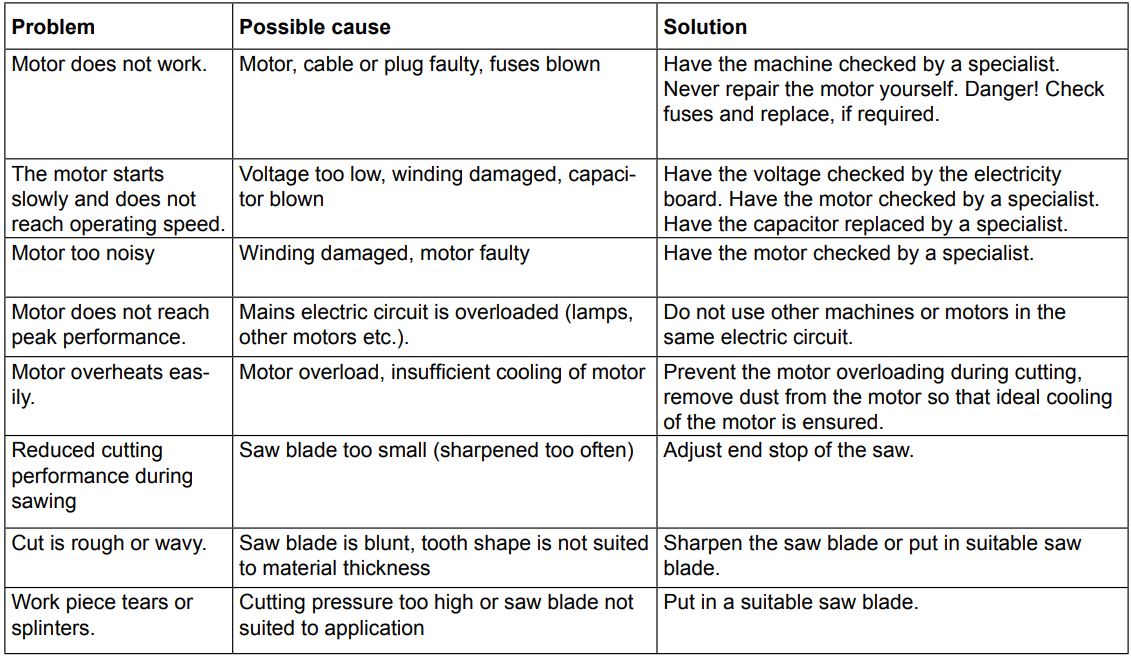
Warning! To protect the motor, it is equipped with a thermal switch which turns it off in the event of overloading. After a short cooling down phase, the motor is turned on again automatically.
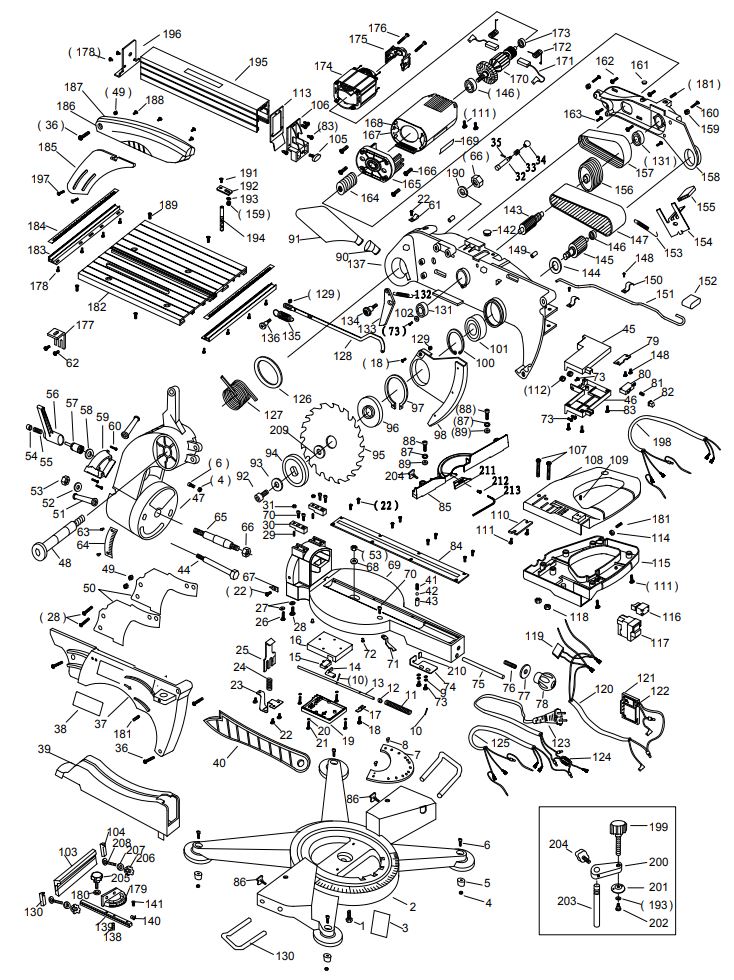
CE – Declaration of Conformity
scheppach Fabrikation von Holzbearbeitungsmaschinen GmbH, Günzburger Str. 69, D-89335 Ichenhausen
hereby declares the following conformity under the EU Directive and standards for the following article

Standard references:
EN 61029-1; EN 61029-2-11; EN 55014-1; EN 55014-2; EN 61000-3-2; EN 61000-3-3
This declaration of conformity is issued under the sole responsibility of the manufacturer.
The object of the declaration described above fulfils the regulations of the directive 2011/65/EU of the European Parliament and Council from 8th June 2011, on the restriction of the use of certain hazardous substances in electrical and electronic equipment.
Ichenhausen, den 22.05.2018
First CE: 2016
Subject to change without notice
Documents registar: Andreas Pecher
Günzburger Str. 69, D-89335 Ichenhausen
Warranty
Apparent defects must be notified within 8 days from the receipt of the goods. Otherwise, the buyers rights of claim due to such defects are invalidated. We guarantee for our machines in case of proper treatment for the time of the statutory warranty period from delivery in such a way that we replace any machine part free of charge which provably becomes unusable due to faulty material or defects of fabrication within such period of time. With respect to parts not manufactured by us we only warrant insofar as we are entitled to warranty claims against the upstream suppliers. The costs for the installation of the new parts shall be borne by the buyer.
The cancellation of sale or the reduction of purchase price as well as any other claims for damages shall be excluded.
scheppach Fabrikation von Holzbearbeitungsmaschinen GmbH | Günzburger Str. 69 |
D-89335 Ichenhausen | www.scheppach.com
